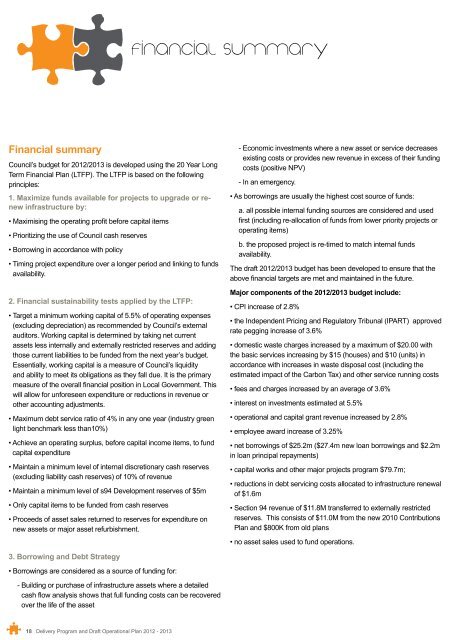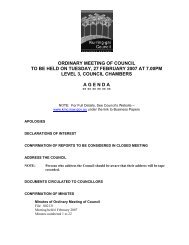Delivery Program and Operational Plan 2012 - 2013 - Ku-ring-gai ...
Delivery Program and Operational Plan 2012 - 2013 - Ku-ring-gai ...
Delivery Program and Operational Plan 2012 - 2013 - Ku-ring-gai ...
Create successful ePaper yourself
Turn your PDF publications into a flip-book with our unique Google optimized e-Paper software.
financial summary<br />
Financial summary<br />
Council’s budget for <strong>2012</strong>/<strong>2013</strong> is developed using the 20 Year Long<br />
Term Financial <strong>Plan</strong> (LTFP). The LTFP is based on the following<br />
principles:<br />
1. Maximize funds available for projects to upgrade or renew<br />
infrastructure by:<br />
• Maximising the operating profit before capital items<br />
• Prioritizing the use of Council cash reserves<br />
• Borrowing in accordance with policy<br />
• Timing project expenditure over a longer period <strong>and</strong> linking to funds<br />
availability.<br />
2. Financial sustainability tests applied by the LTFP:<br />
• Target a minimum working capital of 5.5% of operating expenses<br />
(excluding depreciation) as recommended by Council’s external<br />
auditors. Working capital is determined by taking net current<br />
assets less internally <strong>and</strong> externally restricted reserves <strong>and</strong> adding<br />
those current liabilities to be funded from the next year’s budget.<br />
Essentially, working capital is a measure of Council’s liquidity<br />
<strong>and</strong> ability to meet its obligations as they fall due. It is the primary<br />
measure of the overall financial position in Local Government. This<br />
will allow for unforeseen expenditure or reductions in revenue or<br />
other accounting adjustments.<br />
• Maximum debt service ratio of 4% in any one year (industry green<br />
light benchmark less than10%)<br />
• Achieve an operating surplus, before capital income items, to fund<br />
capital expenditure<br />
• Maintain a minimum level of internal discretionary cash reserves<br />
(excluding liability cash reserves) of 10% of revenue<br />
• Maintain a minimum level of s94 Development reserves of $5m<br />
• Only capital items to be funded from cash reserves<br />
• Proceeds of asset sales returned to reserves for expenditure on<br />
new assets or major asset refurbishment.<br />
- Economic investments where a new asset or service decreases<br />
existing costs or provides new revenue in excess of their funding<br />
costs (positive NPV)<br />
- In an emergency.<br />
• As borrowings are usually the highest cost source of funds:<br />
a. all possible internal funding sources are considered <strong>and</strong> used<br />
first (including re-allocation of funds from lower priority projects or<br />
operating items)<br />
b. the proposed project is re-timed to match internal funds<br />
availability.<br />
The draft <strong>2012</strong>/<strong>2013</strong> budget has been developed to ensure that the<br />
above financial targets are met <strong>and</strong> maintained in the future.<br />
Major components of the <strong>2012</strong>/<strong>2013</strong> budget include:<br />
• CPI increase of 2.8%<br />
• the Independent Pricing <strong>and</strong> Regulatory Tribunal (IPART) approved<br />
rate pegging increase of 3.6%<br />
• domestic waste charges increased by a maximum of $20.00 with<br />
the basic services increasing by $15 (houses) <strong>and</strong> $10 (units) in<br />
accordance with increases in waste disposal cost (including the<br />
estimated impact of the Carbon Tax) <strong>and</strong> other service running costs<br />
• fees <strong>and</strong> charges increased by an average of 3.6%<br />
• interest on investments estimated at 5.5%<br />
• operational <strong>and</strong> capital grant revenue increased by 2.8%<br />
• employee award increase of 3.25%<br />
• net borrowings of $25.2m ($27.4m new loan borrowings <strong>and</strong> $2.2m<br />
in loan principal repayments)<br />
• capital works <strong>and</strong> other major projects program $79.7m;<br />
• reductions in debt servicing costs allocated to infrastructure renewal<br />
of $1.6m<br />
• Section 94 revenue of $11.8M transferred to externally restricted<br />
reserves. This consists of $11.0M from the new 2010 Contributions<br />
<strong>Plan</strong> <strong>and</strong> $800K from old plans<br />
• no asset sales used to fund operations.<br />
3. Borrowing <strong>and</strong> Debt Strategy<br />
• Borrowings are considered as a source of funding for:<br />
- Building or purchase of infrastructure assets where a detailed<br />
cash flow analysis shows that full funding costs can be recovered<br />
over the life of the asset<br />
18 <strong>Delivery</strong> <strong>Program</strong> <strong>and</strong> Draft <strong>Operational</strong> <strong>Plan</strong> <strong>2012</strong> - <strong>2013</strong>

















